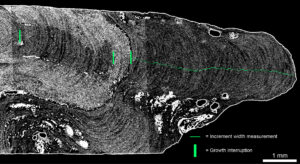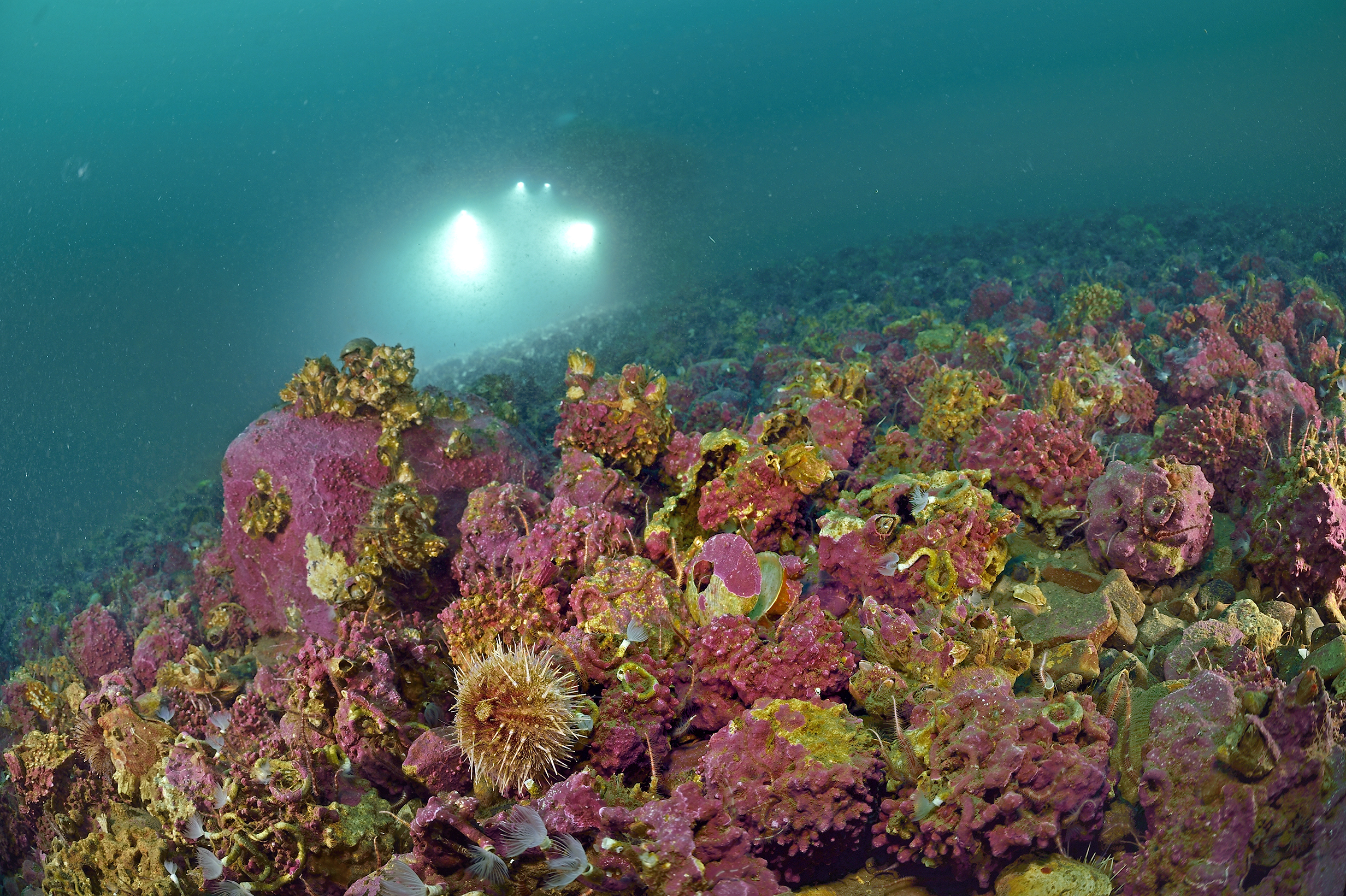About rhodoliths and the impact climate has on these architects of the natural world
Rising water temperatures caused by climate change also put pressure on important ecosystem engineers. While everyone is aware of coral and the huge reefs it forms, other architects of the natural world include certain species of red algae that create less well-known structures such as spheres the size of a fist or handball known as “rhodoliths”. Both constructions offer hiding places, hunting grounds and nurseries for colorful underwater life, thereby providing habits and encouraging biological diversity under the waves. Climate change is having a negative effect not only on coral reefs but also on the red algae structures in icy polar regions. Sebastian Teichert from the Chair of Paleoenvironmental Research at Friedrich-Alexander-Universität Erlangen-Nürnberg (FAU) and his colleagues have now discovered that if water at the surface becomes one degree Celsius warmer, this slows the growth of the rhodolith nodules by more than ten percent. They have published their findings in the journal Global Change Biology.
Together with expedition leader Max Wisshak from the research institute Senckenberg am Meer, the scientist from FAU traveled with the submersible JAGO from the GEOMAR Helmholtz Centre for Ocean Research Kiel to the waters of the Arctic Ocean off the coast of Spitsbergen to collect from the ocean floor the nodules formed by the red algae acting as ecosystem engineers. Contrary to the often delicate and ornate structures found in coral reefs in tropical waters, rhodoliths often lie closely packed on the ocean floor and give the impression of being a colorful underwater scree field. These calcareous nodules are taken by the submersible and transported to the laboratories of the Senckenberg am Meer research institute and to FAU, where Sebastian Teichert examines them in detail.
Usually, a small pebble is found deep inside the rhodoliths, transported to the seabed by the glaciers in the polar regions. In other instances, it may be the shell of a long deceased mollusk. According to Sebastian Teichert, the calcareous nodules are born when “various types of red algae attach themselves to the structure at the core like lichen on bark or stones.” Unlike coral polyps, which are tiny animals, these red algae use sunlight as a source of energy, similarly to lichen and all plants on land. In order to anchor themselves securely in the water or on the often soft ocean floor, the algae secrete lime. Over the years, this forms a solid layer that protects the otherwise vulnerable algae.

If the small underwater plants grow between the branches of reefs, their lime can act like cement in walls built by human architects to bind the underwater structures of the coral reefs. If the red algae grow on a pebble or a shell, over time they form spheres, or nodules, that may at some point be collected from the ocean floor for research purposes. With a diameter of 15 to 20 centimeters, the nodules can be nearly the same size as the ball used for a professional handball match. On the upper layers of this ball made of lime, the red algae catch sunlight and continue to grow slowly. In contrast, the deeper layers have long died off. This offers the perfect hiding place for piddocks, which are approximately three centimeters in size. They drill their way through the outer shell until they reach a depth where they are safe from predators. Water flows from outside through a small channel to the piddocks, from which they filter their food. “A dozen such molluscs can live in a single rhodolith without harming the red algae,” explains Sebastian Teichert. After these lodgers die, other molluscs or brittle stars take their place. Brittle stars are one of the cod’s favorite prey, which is in turn a common item on menus in Europe. The colorful scree fields on the ocean floor by the British Isles therefore also have an indirect impact on the fishing industry.
At the same time, the rhodoliths are crucial for biodiversity. Analyses in laboratories at FAU have shown that one single, fist-sized nodule can be home to eleven different species. In order to find out more about the history of these calcareous nodules, Sebastian Teichert takes a diamond drill to drill carefully into 27 rhodoliths taken from various depths from the ocean at Spitsbergen. He then uses a CT scanner specially adapted for very small objects to expose the 4.5 millimeter thick core samples to x-rays. Similarly to how growth rings in trees can indicate the age of a tree, Sebastian Teichert can see zones in the core samples that reflect the annual growth of the nodules. He then uses cutting edge statistical methods to analyze these data together with Carl Reddin from the Alfred Wegener Institute, Helmholtz Centre for Polar and Marine Research in Bremerhaven.
“We got good results from more than 20 of these core samples, allowing us to work with a comprehensive dataset for the first time so far,” Sebastian Teichert explains. The researchers discovered that the rhodoliths only grow 85 micrometers, or just under one tenth of a millimeter, per year. This means that their rate of growth is several orders of magnitude slower than a healthy finger nail, that usually grows between half and just over one millimeter per week. However, the calcareous nodules can keep growing at this snail’s pace over a very long period of time. The oldest rhodolith that was examined has been growing since 1926. Other calcareous nodules may be even older, but as they interrupted their growth for a certain period it was impossible to analyze their growth rings.
It has become clear, however, that climate change is slowing rhodoliths’ growth. If the surface water becomes just one degree Celsius warmer, the nodules’ rate of growth decreases by 8.9 micrometers or nearly one hundredth of a millimeter in a year. If rising temperatures cause these ecosystem engineers to slow down, this will naturally have a knock-on effect on biodiversity. This effect can be seen particularly clearly at a water depth of eleven meters. At a depth of 27 meters, the rising temperatures have less of an effect on growth and the impact at 46 meters below the waves is even less obvious. Sebastian Teichert conjectures that “this is probably due to the different currents that transport warmer water quicker to lower depths than down to the deeper depths of the ocean.”
“That sounds surprising at first, as in theory algae should actually be able to grow quicker at higher temperatures,” he continues. He does not know exactly why climate change is slowing the growth of the rhodoliths, but he has three plausible explanations. Red algae can adjust well to different temperatures. For example, the same species can cause rhodoliths to grow in the water off the coast of Scotland, where the water reaches temperatures of ten degrees Celsius, and in the water off the coast of Spitsbergen, where in the months of July and August temperatures barely reach zero degrees, or possibly very slightly warmer. However, adjusting to rising temperatures takes several generations. For species that live as long as the red algae in their calcareous nodules, climate change is raising water temperatures at speeds that exceed the organisms’ ability to adapt.
“It is also possible that the water from the melting ice masses on Spitsbergen may make the sea murky, meaning that the red algae catch less sunlight, and therefore have less energy,” Sebastian Teichert suggests. Furthermore, water is becoming more acidic as a result of climate change, thereby preventing the secretion of lime, which ceases entirely once the water reaches a certain degree of acidity. Perhaps all three factors are at play, or other factors may also make a contribution to slowing the growth of the calcareous nodules and having a negative impact on biodiversity due to climate change.
Read the full article
Are you interested in diving into this study’s details? Click here to read the article online: In situ decrease in rhodolith growth associated with Arctic climate change.
Further information
Dr. Sebastian Teichert
Phone: 09131/85 26958
sebastian.teichert@fau.de

